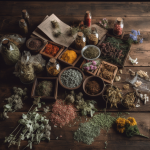In a world where uncertainty lingers, it is crucial to equip ourselves with the knowledge and skills that can help us survive. One such skill is foraging, a practice that taps into the bountiful offerings of nature throughout the year. By learning to identify and harvest wild plants, nuts, and berries, we can ensure a reliable food source even in the face of a crisis. Let us delve into a seasonal guide that will aid in your journey towards self-reliance.
Spring – The Dawn of Abundance:
As the harsh grip of winter eases, the arrival of spring brings forth a plethora of edible treasures. Look out for vibrant and nutrient-rich greens like chickweed, dandelion, and garlic mustard. Embrace the tangy delight of wild sorrel and the refreshing zing of wood sorrel. Additionally, don’t let the delicate blossoms of violets and elderflowers go unnoticed, as they can be transformed into delectable treats.
Summer – Nature’s Cornucopia:
Summer paints the natural world in vivid shades and gifts us an abundance of edible wonders. This season offers an array of wild berries such as blackberries, raspberries, and blueberries, ripe for the picking. Nuts like hazelnuts, acorns, and walnuts also make their appearance. Experiment with different ways to preserve these summertime treasures and savor them during the leaner months.
Fall – A Harvest of Plenty:
As nature prepares for its impending slumber, the fall season provides an opportunity to stockpile for the winter ahead. Seek out rosehips, a valuable source of vitamin C, and the tart and versatile cranberries. Oak trees offer a generous supply of acorns that can be processed into flour or used as a coffee substitute. Don’t forget about the mighty hickory, whose nut can be enjoyed raw or roasted.
Winter – Nature’s Dormant Pantry:
While the winter landscape may seem barren, it still holds secrets to sustain us. Focus on hardy evergreen plants such as pine, spruce, and juniper. These trees provide nourishing needles and branches that can be used to make tea, adding warmth and essential vitamins to our diet. Seek out cold-hardy wild roots such as dandelion, chicory, and burdock, which can be harvested beneath the frozen ground.
The clock is ticking, and we must act now to arm ourselves with the knowledge of foraging. However, a word of caution: never eat a plant or berry that you cannot confidently identify. Always consult reliable sources and, if possible, seek guidance from experienced foragers. Safety should be a priority, as ignorance can have severe consequences.
By following this seasonal guide to foraging, we can develop our self-reliance skills and alleviate the fears that often accompany thoughts of a crisis. Remember, preparedness begins with education and action. As we learn to forage, we not only open the door to a sustainable food source but also build resilience and self-reliance. The time to acquire these vital skills is now. A bountiful supply of nature’s gifts awaits – are you prepared to receive them?



GIPHY App Key not set. Please check settings